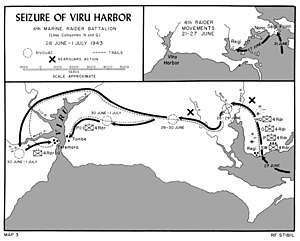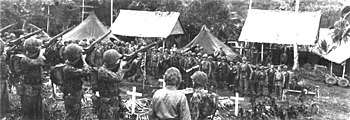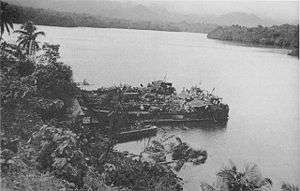Battle of Viru Harbor
The Battle of Viru Harbor was a battle of the Pacific campaign of World War II that took place on New Georgia island during the New Georgia Campaign from 28 June – 1 July 1943. It was one of the first actions of the campaign and involved an overland advance by elements of a Marine Raider battalion, supported by a United States Army infantry company. Supported by airstrikes, the Marines carried out an enveloping attack on the Japanese defenders around the harbor and forced them to withdraw. The harbor was subsequently used by US forces to support further operations, although plans to build a PT boat base in the area were later canceled when the harbor was found to be unsuitable.
Background
The battle was one of the first actions of the New Georgia campaign. Located on the southwestern coast of New Georgia island, Viru Harbor lies along a key avenue of approach towards Rendova and Munda Point.[1] In formulating their plans to secure the New Georgia islands, US planners assessed that several preliminary operations were required ahead of the main operation to capture Japanese airfield at Munda Point. This included the capture of Viru Harbor. Because of its proximity to New Georgia, it offered the Allies an important sheltered harbor that could support lines of supply as they advanced north from the Solomons through New Georgia and towards Bougainville. Consequently, they planned to use the area as a staging base for landing craft proceeding towards Rendova, where the main US force would be built up prior to landing around Zanana and advancing to Munda Point to capture the Japanese airfield there.[2][3]

Other preliminary operations were envisaged to capture Wickham Anchorage to secure staging base further south to provide a chain to support the movement of troops and equipment from the Russells and Guadalcanal. Another operation was also envisaged to capture Segi Point as a location for an airfield; these operations were to be conducted simultaneously at the end of June, but the Segi Point operation was brought forward due to concerns about the safety of Allied intelligence personnel, including District Officer Donald Gilbert Kennedy, a New Zealand coastwatcher, operating in the area.[4][5][6]
Segi Point was subsequently secured by an unopposed landing from two companies from Lieutenant Colonel Michael S. Currin's 4th Marine Raider Battalion (Companies O and P) that had embarked upon the high speed transports Dent and Waters. The Marines were later reinforced by two companies from the 103rd Infantry Regiment (Companies A and D), which landed on 22 June from the transports Schley and Crosby. Currin's force then established a defensive position and began patrolling the nearby area.[7][8]
Battle
The original US plan for the capture of Viru Harbor involved B Company, 103rd Infantry Regiment (Captain Raymond Kinch)[9] coming ashore directly inside the harbor from three destroyer-transports (Hopkins, Kilty and Crosby), while Companies O and P from the 4th Marine Raider Battalion—other elements from the battalion had been sent to secure Wickham Anchorage[10]—advanced overland from Regi, near Lambeti Village, to the south. The Segi beachhead would be held by the Companies A and D, 103rd Infantry Regiment.[11] The Marines had begun moving to Regi by rubber boats from Segi Point on 27 June,[10] having arrived at Segi Point on 21 June during the preliminary operation to protect Kennedy and his small group of local forces.[12] The troops from B Company, 103rd Infantry Regiment were reinforced by part of D Company, 103rd Infantry Regiment and were supported by a battery of the 70th Coast Artillery Battalion and part of Company D, 20th Naval Construction Battalion.[13][14] These troops formed part of Colonel Daniel H. Hundley's Eastern Landing Force.[15]

The Japanese troops defending the area were commanded by First Lieutenant Takagi and amounted to 245 men from a company from Major Masao Hara's 1st Battalion, 229th Infantry Regiment (Colonel Genjiro Hirata), which had been detached from Major General Minoru Sasaki's Southeast Detachment. Hara's infantry company was reinforced by personnel from Commander Saburo Okumura's Kure 6th and the Yokosuka 7th Special Naval Landing Forces under Commander Takeda Kashin. Together these units formed part of the 8th Combined Special Naval Landing Force. Fire support included several guns including a 3-inch coast defense gun, four 80 mm guns, and eight other guns of varying types and calibers.[16][17][18]
The US destroyer-transports entered the harbor early on 30 June, but found that the Marines' advance had been delayed. Coming under fire from a Japanese 3-inch field gun from Tetemara Point, and having been unable to establish radio contact with Currin's Marines, the US naval commander, Commander Stanley Leith, decided to withdraw from the harbor.[19] After waiting offshore for the agreed upon signal from the Marines while remaining out of range of the defending Japanese coastal artillery, the ships moved towards Segi Point instead, landing the company from the 103rd Infantry at Nono.[10] Leith assessed that the Marines were potentially in trouble and needed assistance, which could be provided by Kinch's company if they advanced overland to link up with them. As the landing force departed Viru Harbor, Hara reported that his forces had repulsed the landing attempt.[20]
Meanwhile, the Marine raiders' approach saw them advance 12 miles (19 km) through dense terrain, and had been delayed due to several skirmishes with the Imperial Japanese Navy and Army troops that were guarding the approaches to Viru Harbor.[21] During the advance, Currin's men clashed with Japanese troops around the Lambeti Plantation on both sides of the Lakuru River on 28 June and then again around the Choi River on 29 June.[22] He then received intelligence that the main concentration of Japanese forces was around the western shore of the harbor, at Tetemara, with an outpost across the harbor at Tombe.[23]

The Marines stopped short of the junction of the Tetemara–Tombe trails, close to their objective (Viru Harbor) on the evening of 30 June, and prepared to launch their attack the following day. Currin's men subsequently launched two-pronged attack the following morning; two platoons were detached to attack Tombe from the northeast, while the rest of the regiment skirted around the harbor to the north, crossing the Viru, Tita and Mango Rivers, and assaulted Tetemara from the southwest.[24] The outpost at Tombe was quickly overwhelmed around 08:45 on 1 July, while the main body of Marines drove the Japanese out of Viru in a running battle that lasted until the early afternoon. They were supported by preliminary air attacks by seventeen US Navy Dauntless dive-bombers, while landing craft with combat supplies (ammunition and fuel) entered the harbor to ensure rapid resupply. As Hara's troops withdrew into the jungle, the Marines began constructing defensive positions to wait for reinforcement.[25][26]
Aftermath
Casualties amounted to 13 US personnel killed and 15 wounded, while 61 Japanese were killed and around 100 were wounded.[27][25] The surviving members of Hara's 1st Battalion, 229th Infantry Regiment, totaling about 170 men,[28] spent the next two weeks withdrawing back to Munda where they were concentrated around Lambeti Plantation—halfway between Munda Point and Ilangana—during preparations for a counterattack in mid-July.[29] On 4 July, Viru Harbor was occupied by the company from the 103rd Infantry Regiment which followed the Marines' advance overland and U.S. Navy personnel and ships.[21] The troops from 4th Marine Raider Battalion and 103rd Infantry Regiment held the area until 9 July when they were relieved; Currin's men returned to Guadalcanal.[25] They were later sent to reinforce Colonel Harry B. Liversedge's Northern Landing Group around Bairoko, arriving off Enogai Point on 18 July.[30]
In the aftermath of the battle, Segi Point was subsequently developed into an airfield, while Viru Harbor was to developed into a staging base to support subsequent operations aimed at supporting the Landings on Rendova and the Drive on Munda Point.[21] Nevertheless, plans to establish a PT boat base in the harbor were canceled when the harbor was determined to be unsuitable. Personnel from the 20th Naval Construction Battalion remained in the area until October 1943, working to unload vessels and carry out base development tasks. This included road construction and improvement, construction of a marine railway, and construction and occupation of beach defenses. They also worked to repair the already existing 50-by-30-foot (15.2 by 9.1 m) wharf utilizing local materials, including coral and coconut tree logs.[31]
Notes
- Miller p. 69 (map)
- Rentz pp. 25–29
- Miller p. 93
- Rentz pp. 25, 29 & 37
- Miller p. 73
- Morison p. 141
- Rentz pp. 37–40
- Shaw & Kane p. 53
- Shaw & Kane p. 70
- Miller pp. 81–84
- Rentz p. 38
- Morison p. 141
- Rentz p. 26
- Miller p. 80
- Miller p. 82
- Rentz, pp. 24 and 37
- Rottman pp. 65–66.
- Day p. 79
- Rentz p. 41
- Rentz pp. 41–42
- Miller pp. 84–85
- Rentz p. 41 (map)
- Rentz p. 42
- Rentz pp. 42–43
- Rentz p. 43
- Morison p. 152
- Melson, p. 6
- Rottman p. 66
- Rentz pp. 43, 82 (note 61) & 85 (map)
- Shaw & Kane, pp. 133–134
- Bureau of Yards and Docks, pp. 264–265
References
- Bureau of Yards and Docks (1947). Building the Navy's Bases in World War II: History of the Bureau of Yards and Docks and the Civil Engineer Corps, 1940–1964. II. Washington DC: Department of the Navy. OCLC 80964080.
- Day, Ronnie (2016). New Georgia: The Second Battle for the Solomons. Indiana University Press. ISBN 0253018773.
- Melson, Charles D. (1993). "Up the Slot: Marines in the Central Solomons". World War II Commemorative Series. History and Museums Division, Headquarters, U.S. Marine Corps. p. 36. Retrieved September 26, 2006.
- Miller, John, Jr. (1959). "Cartwheel: The Reduction of Rabaul". United States Army in World War II: The War in the Pacific. Office of the Chief of Military History, U.S. Department of the Army. Retrieved October 20, 2006.
- Morison, Samuel Eliot (1958). Breaking the Bismarcks Barrier, vol. 6 of History of United States Naval Operations in World War II. Castle Books. 0785813071.
- Rentz, John (1952). "Marines in the Central Solomons". Historical Branch, Headquarters, U.S. Marine Corps. Retrieved May 30, 2006.
- Rottman, Gordon L. (2005). Duncan Anderson (ed.). Japanese Army in World War II: The South Pacific and New Guinea, 1942–43. Oxford and New York: Osprey. ISBN 1-84176-870-7.
- Shaw, Henry I.; Douglas T. Kane (1963). "Volume II: Isolation of Rabaul". History of U.S. Marine Corps Operations in World War II. Archived from the original on 20 November 2006. Retrieved 18 October 2006.
Further reading
- Altobello, Brian (2000). Into the Shadows Furious. Presidio Press. ISBN 0-89141-717-6.
- Craven, Wesley Frank; James Lea Cate. "Vol. IV, The Pacific: Guadalcanal to Saipan, August 1942 to July 1944". The Army Air Forces in World War II. U.S. Office of Air Force History. Archived from the original on 26 November 2006. Retrieved October 20, 2006.
- Dyer, George Carroll. "The Amphibians Came to Conquer: The Story of Admiral Richmond Kelly Turner". United States Government Printing Office. Archived from the original on 12 September 2006. Retrieved October 20, 2006.
- Hammel, Eric M. (2008). New Georgia, Bougainville, and Cape Gloucester: The U.S. Marines in World War II A Pictorial Tribute. Pacifica Press. ISBN 0-7603-3296-7.
- Hammel, Eric M. (1999). Munda Trail: The New Georgia Campaign, June–August 1943. Pacifica Press. ISBN 0-935553-38-X.
- Hoffman, Jon T. (1995). "New Georgia" (brochure). From Makin to Bougainville: Marine Raiders in the Pacific War. Marine Corps Historical Center. Retrieved 2006-11-21.
- Lofgren, Stephen J. Northern Solomons. The U.S. Army Campaigns of World War II. United States Army Center of Military History. p. 36. CMH Pub 72-10. Retrieved October 18, 2006.
- Mersky, Peter B. (1993). "Time of the Aces: Marine Pilots in the Solomons, 1942–1944". Marines in World War II Commemorative Series. History and Museums Division, Headquarters, U.S. Marine Corps. Retrieved October 20, 2006.
- McGee, William L. (2002). The Solomons Campaigns, 1942–1943: From Guadalcanal to Bougainville—Pacific War Turning Point, Volume 2 (Amphibious Operations in the South Pacific in WWII). BMC Publications. ISBN 0-9701678-7-3.
- Peatross, Oscar F. (1995). John P. McCarthy; John Clayborne (eds.). Bless 'em All: The Raider Marines of World War II. Review. ISBN 0-9652325-0-6.
- United States Army Center of Military History. "Japanese Operations in the Southwest Pacific Area, Volume II – Part I". Reports of General MacArthur. Retrieved 2006-12-08.- Translation of the official record by the Japanese Demobilization Bureaux detailing the Imperial Japanese Army and Navy's participation in the Southwest Pacific area of the Pacific War.
